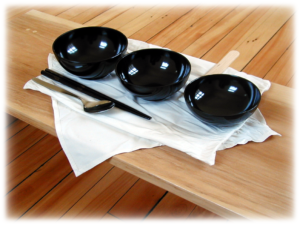 Oryoki (roughly meaning “just enough”) is a formal way of serving and eating meals in Zen monasteries. Literally a “vessel” (ki 器) that contains an “appropriate amount” (ōryō 應量) of food. In India, Buddhist monks carried a bowl (S. pātra) when soliciting alms food from the laity that was supposed to be large enough to hold a nourishing meal but small enough to prevent gluttony. The bowl was one of the few personal possessions Buddhist monks were allowed to have. Received upon ordination as a novice monk along with the patchwork robe (S. kāṣāya), it is emblematic of membership in the monastic order. As Buddhism evolved in India, it became the accepted norm for monasteries to have stores of food, kitchens, and dining halls for communal meals, but the bowl (or set of bowls) in which the meal was received and eaten remained the personal property of individual monks. In Soto Zen today, monks receive a set of nested bowls (made of lacquered wood) upon ordination and use them for formal meals when residing in training monasteries.
Oryoki (roughly meaning “just enough”) is a formal way of serving and eating meals in Zen monasteries. Literally a “vessel” (ki 器) that contains an “appropriate amount” (ōryō 應量) of food. In India, Buddhist monks carried a bowl (S. pātra) when soliciting alms food from the laity that was supposed to be large enough to hold a nourishing meal but small enough to prevent gluttony. The bowl was one of the few personal possessions Buddhist monks were allowed to have. Received upon ordination as a novice monk along with the patchwork robe (S. kāṣāya), it is emblematic of membership in the monastic order. As Buddhism evolved in India, it became the accepted norm for monasteries to have stores of food, kitchens, and dining halls for communal meals, but the bowl (or set of bowls) in which the meal was received and eaten remained the personal property of individual monks. In Soto Zen today, monks receive a set of nested bowls (made of lacquered wood) upon ordination and use them for formal meals when residing in training monasteries.
At AZC, we take up this ancient and traditional method of eating meals during retreats and sesshins.
- AZC’s 17-min Oryoki Instruction Video (on YouTube)
- AZC Oryoki Serving Instruction Manual
- Les Kaye’s (Kannon-Do) Oryoki Instruction Manual
- Official Sōtō-Shu* Oryoki Instructions (on Soto Zen-Net)
* What is the Sōtō-Shu?
Share this:
- Click to email a link to a friend (Opens in new window) Email
- Click to share on Facebook (Opens in new window) Facebook
- Click to share on Telegram (Opens in new window) Telegram
- Click to share on Bluesky (Opens in new window) Bluesky
- Click to share on X (Opens in new window) X
- Click to share on LinkedIn (Opens in new window) LinkedIn
